Determination of the Structural Characteristic of the Refractive Index of Optical Waves in the Atmospheric Boundary Layer with Remote Acoustic Sounding Facilities
Abstract
:1. Introduction
2. Experimental Section
2.1. Method for Determination of Structural Characteristics
2.2. Instrumentation and Measurement Site
2.3. Method for Fitting Calibration Coefficients
3. Results and Discussion
4. Conclusions
Author Contributions
Funding
Conflicts of Interest
References
- Tatarski, V.I. Wave Propagation in a Turbulent Medium; McGraw-Hill: New York, NY, USA, 1961. [Google Scholar]
- Stroben, J.W. Laser Beam Propagation in the Atmosphere; Springer: Berlin, Germany, 1978. [Google Scholar]
- Zuev, V.E. Laser Beams in the Atmosphere; Springer: New York, NY, USA, 1982. [Google Scholar]
- Mironov, V.L. Laser Beam Propagation in the Turbulent Atmosphere; Nauka: Novosibirsk, Russia, 1981. (In Russian) [Google Scholar]
- Braam, M.; Moene, A.F.; Beyrich, F. Variability of the structure parameters of temperature and humidity observed in the atmospheric surface layer under unstable conditions. Bound. Layer Meteorol. 2014, 150, 399–422. [Google Scholar] [CrossRef]
- Braam, M.; Moene, A.F.; Beyrich, F.; Holstlag, A.A.M. Similarity relations for CT2 in the unstable atmospheric surface layer: Dependence on regression approach, observation height and stability range. Bound. Layer Meteorol. 2014, 153, 63–87. [Google Scholar] [CrossRef]
- Braam, M.; Beyrich, F.; Bange, J.; Platis, A.; Martin, S.; Maronga, B.; Moene, A.F. On the discrepancy in simultaneous observations of structure parameter of temperature using scintillometer and unmanned aircraft. Bound. Layer Meteorol. 2016, 158, 257–283. [Google Scholar] [CrossRef]
- Wainwright, C.E.; Bonin, T.A.; Chilson, P.B.; Gibbs, J.A.; Fedorovich, E.; Palmer, R.D. Methods for evaluating the temperature structure-function parameter using unmanned aerial systems and large-eddy simulation. Bound. Layer Meteorol. 2015, 155, 189–208. [Google Scholar] [CrossRef]
- Bonin, T.A.; Goines, D.C.; Scott, A.K.; Wainwright, C.E.; Gibbs, J.A.; Chilson, P.C. Measurements of the temperature structure-function parameters with a small unmanned aerial system compared with a sodar. Bound. Layer Meteorol. 2015, 155, 417–434. [Google Scholar] [CrossRef]
- Martini, E.; Freni, A.; Cuccoli, F.; Facheris, L. Derivation of clear-air turbulence parameters from high-resolution radiosonde data. J. Atmos. Ocean. Technol. 2017, 34, 277–293. [Google Scholar] [CrossRef]
- Vernin, J.; Trinquet, H.; Jumper, G.; Murphy, E.; Ratkovski, A. OHP02 gravity wave campaign in relation to optical turbulence. Environ. Fluid Mech. 2007, 7, 371–382. [Google Scholar] [CrossRef]
- Trinquet, H.; Vernin, J. A statistical model to forecast the profile of the index structure constant Cn2. Environ. Fluid Mech. 2007, 7, 397–407. [Google Scholar] [CrossRef]
- Nosov, V.V.; Lukin, V.P.; Nosov, E.V.; Torgaev, A.V. Method for atmospheric turbulence profile measurement from observation of laser guide stars. Atmos. Ocean. Opt. 2017, 30, 176–183. [Google Scholar] [CrossRef]
- Bal’basova, L.A.; Lukin, V.P. Adaptive Correction of Atmospheric Distortions of Optical Images Against an Artificial Guide Star; Fizmatlit: Moscow, Russia, 2012; p. 128. (In Russian) [Google Scholar]
- Ziad, A.; Chabe, J.; Fantei-Caujolle, Y.; Aristidi, E.; Renaud, C.; Rahhal, M.B. CATS: An autonomous station for atmospheric turbulence characterization. Proc. SPIE 2018, 10703, 107036L. [Google Scholar]
- Sprung, D.; Sucher, E.; Ramkilowan, A.; Griffith, D.J. Investigation of optical turbulence in the atmospheric surface layer using scintillometer measurements along a slant path and comparison to ultrasonic anemometer measurements. Proc. SPIE 2014, 9242, 92421I. [Google Scholar]
- Andrews, L.C.; Phillips, R.L.; Crabbs, R.; Wayne, D.; Leclerc, T.; Sauer, P. Creating a Cn2 profile as a function of altitude using scintillation measurements along a slant path. Proc. SPIE 2012, 8238, 82380F. [Google Scholar]
- Razenkov, I.A. Turbulent Lidar: I−Design. Atmos. Ocean. Opt. 2018, 31, 273–280. [Google Scholar] [CrossRef]
- Razenkov, I.A. Turbulent Lidar: II−Experiment. Atmos. Ocean. Opt. 2018, 31, 281–289. [Google Scholar] [CrossRef]
- Petenko, I.; Argentini, S.; Casasanta, G.; Genthon, C.; Kallistratova, M. Stable surface-based turbulent layer during the polar winter at Dome C, Antarctica: Sodar and in situ observations. Bound. Layer Meteorol. 2019, 171, 101–128. [Google Scholar] [CrossRef]
- Petenko, I.; Mastrantonio, G.; Viola, A.; Argentini, S.; Pietroni, I. Some statistics of the temperature structure parameter in the convective boundary layer observed by sodar. Bound. Layer Meteorol. 2014, 150, 215–233. [Google Scholar] [CrossRef]
- Travouillon, T.; Schöck, M.; Els, S.; Riddle, R.; Skidmore, W. Using sodar to measure optical turbulence and wind speed for the meter telescope site testing. Part I: Reproducibility. Bound. Layer Meteorol. 2011, 141, 273–288. [Google Scholar] [CrossRef]
- Pan, N.; Li, C. Deduction or sensible heat flux from SODAR data. Adv. Atmos. Sci. 2008, 25, 253–266. [Google Scholar] [CrossRef]
- Odintsov, S.L.; Gladkikh, V.A.; Kamardin, A.P.; Nevzorova, I.V. Results of acoustic diagnostics of atmospheric boundary layer in estimation of the turbulence effect on laser beam parameters. Atmos. Ocean. Opt. 2018, 31, 553–563. [Google Scholar] [CrossRef]
- Odintsov, S.L.; Gladkikh, V.A.; Kamardin, A.P.; Mamyshev, V.P.; Nevzorova, I.V. Estimation of the Turbulence and Regular Refraction Effects on Laser Beam Parameters in the Atmospheric Boundary Layer: Part 1: Coherence Length and Turbulent Broadening. Atmos. Ocean. Opt. 2019, 32, 19–25. [Google Scholar] [CrossRef]
- Kamardin, A.P.; Odintsov, S.L. Height Profiles of the Structure Characteristic of Air Temperature in the Atmospheric Boundary Layer from Sodar Measurements. Atmos. Ocean. Opt. 2017, 30, 33–38. [Google Scholar] [CrossRef]
- Gladkikh, V.A.; Odintsov, S.L. Calibration of Volna-3 sodar. Atmos. Ocean. Opt. 2001, 14, 1050–1053. [Google Scholar]
- Kamardin, A.P.; Odintsov, S.L. Method for automatic absolute calibration of sodar measurement channels. Proc. SPIE 2015, 9680, 96805U. [Google Scholar]
- Odintsov, S.L.; Gladkikh, V.A.; Kamardin, A.P.; Mamyshev, V.P.; Nevzorova, I.V. Estimates of the Refractive Index and Regular Refraction of Optical Waves in the Atmospheric Boundary Layer: Part 1, Refractive Index. Atmos. Ocean. Opt. 2018, 31, 437–444. [Google Scholar] [CrossRef]
- Kamardin, A.P.; Gladkikh, V.A.; Odintsov, S.L.; Fedorov, V.A. VOLNA-4M-CT Acoustic Doppler Radar (Sodar). Pribory 2017, 202, 37–44. (In Russian) [Google Scholar]
- Gladkikh, V.A.; Makienko, A.E. Digital Ultrasonic Meteostation. Pribory 2009, 109, 21–25. (In Russian) [Google Scholar]
- Kadygrov, E.N.; Kuznetsova, I.N. Methodical Recommendations on the Use of Data of Remote Measurements of Temperature Profiles in the Boundary Layer by a Microwave Profilometers: Theory and Practice; Fizmatkniga: Dolgoprudnyi, Russia, 2015; p. 171. (In Russian) [Google Scholar]
- Gladkikh, V.A.; Nevzorova, I.V.; Odintsov, S.L.; Fedorov, V.A. Structure functions of air temperature over an inhomogeneous underlying surface. Part, I. Typical forms of structure functions. Atmos. Ocean. Opt. 2014, 27, 147–153. [Google Scholar] [CrossRef]
- Gladkikh, V.A.; Nevzorova, I.V.; Odintsov, S.L.; Fedorov, V.A. Structure functions of air temperature over an inhomogeneous underlying surface. Part II. Statistics of structure functions’ parameters. Atmos. Ocean. Opt. 2014, 27, 154–163. [Google Scholar] [CrossRef]
- Bol’basova, L.A.; Lukin, V.P. Analytical models of vertical profile of the structure parameter of atmospheric refractive index for adaptive optics. Atmos. Ocean. Opt. 2016, 29, 918–925. (In Russian) [Google Scholar]
- Odintsov, S.L.; Gladkikh, V.A.; Kamardin, A.P.; Mamyshev, V.P.; Nevzorova, I.V. Estimation of the Turbulence and Regular Refraction Effect on Laser Beam Parameters in the Atmospheric Boundary Layer: Part 2, Laser Beam Broadening under Strong Regular Refraction. Atmos. Ocean. Opt. 2019, 32, 26–32. [Google Scholar] [CrossRef]
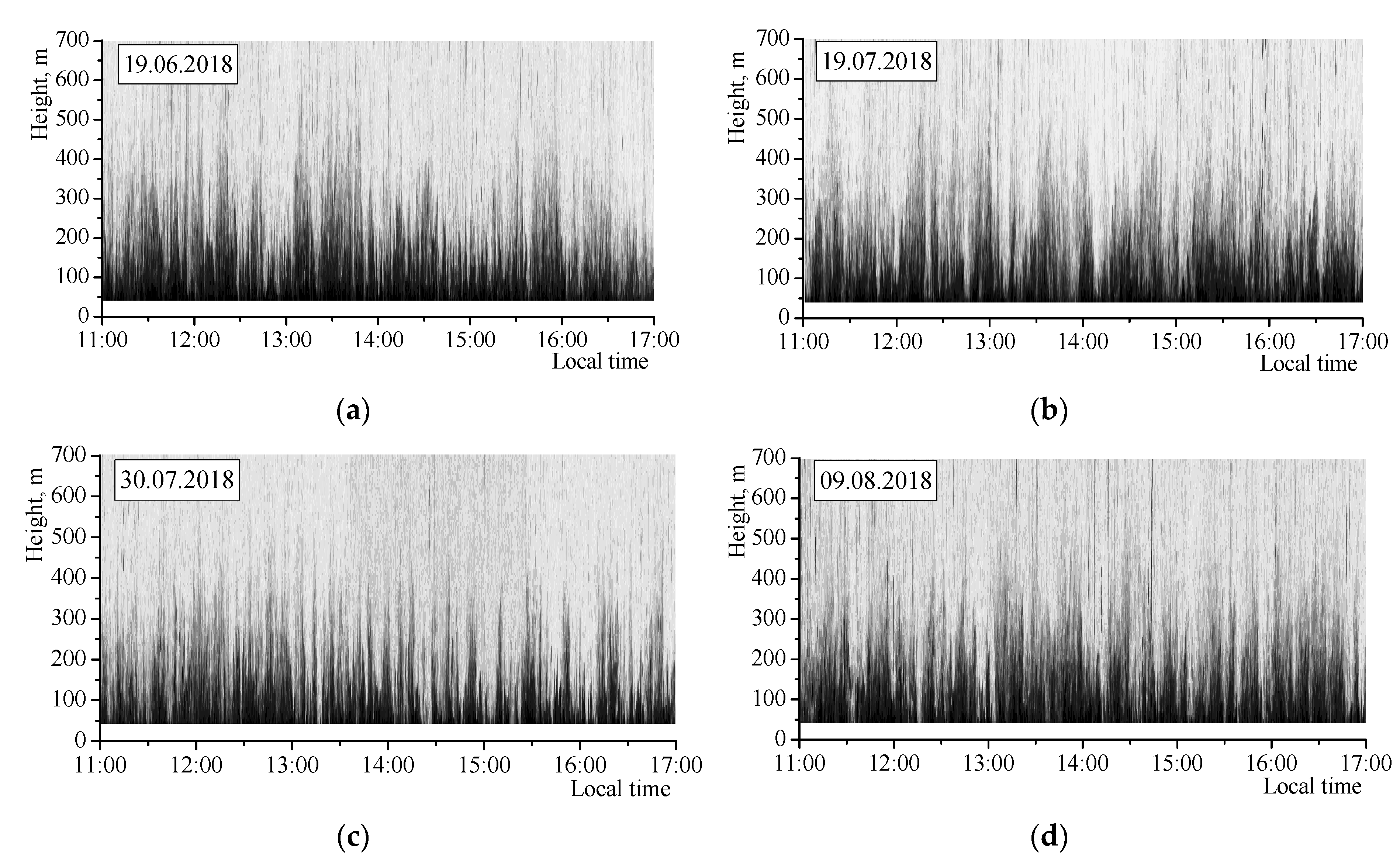
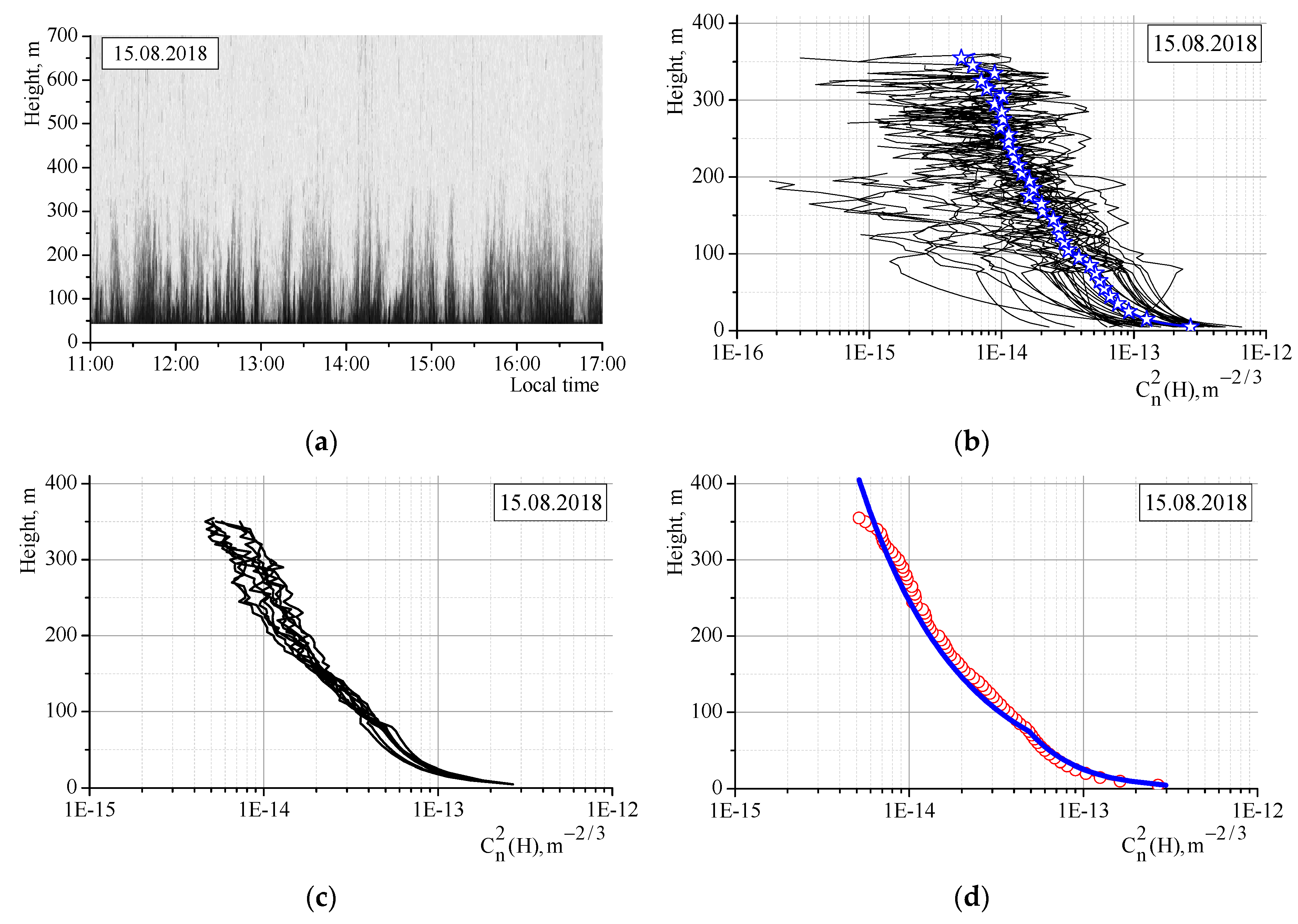

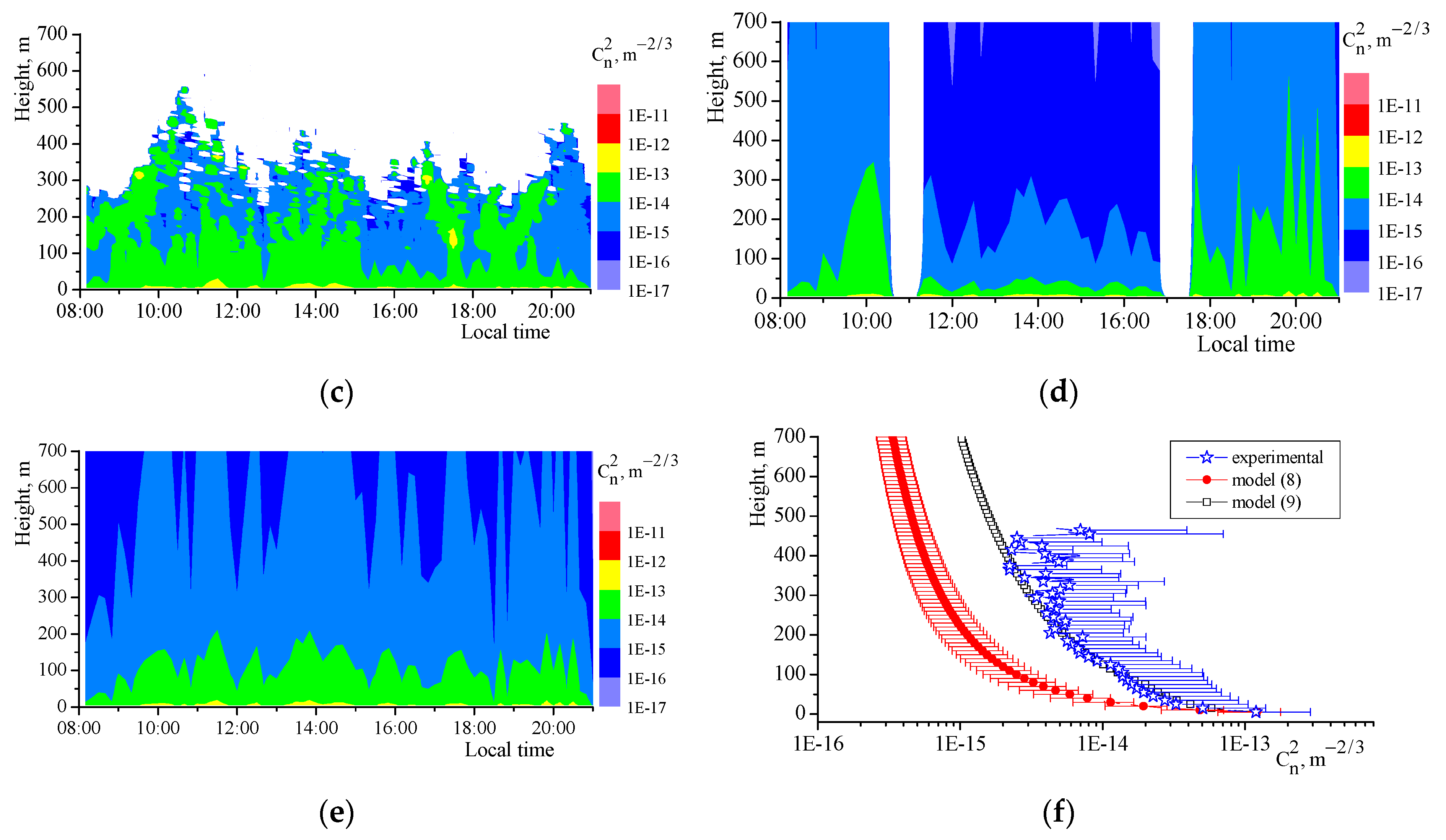
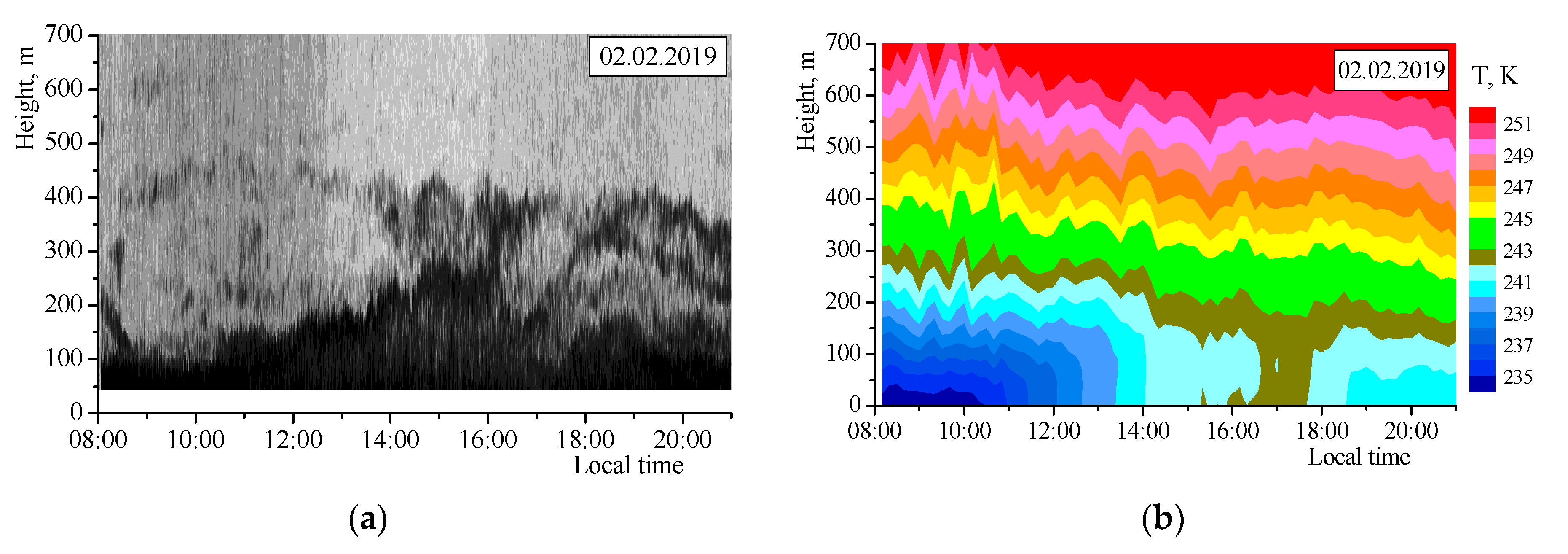
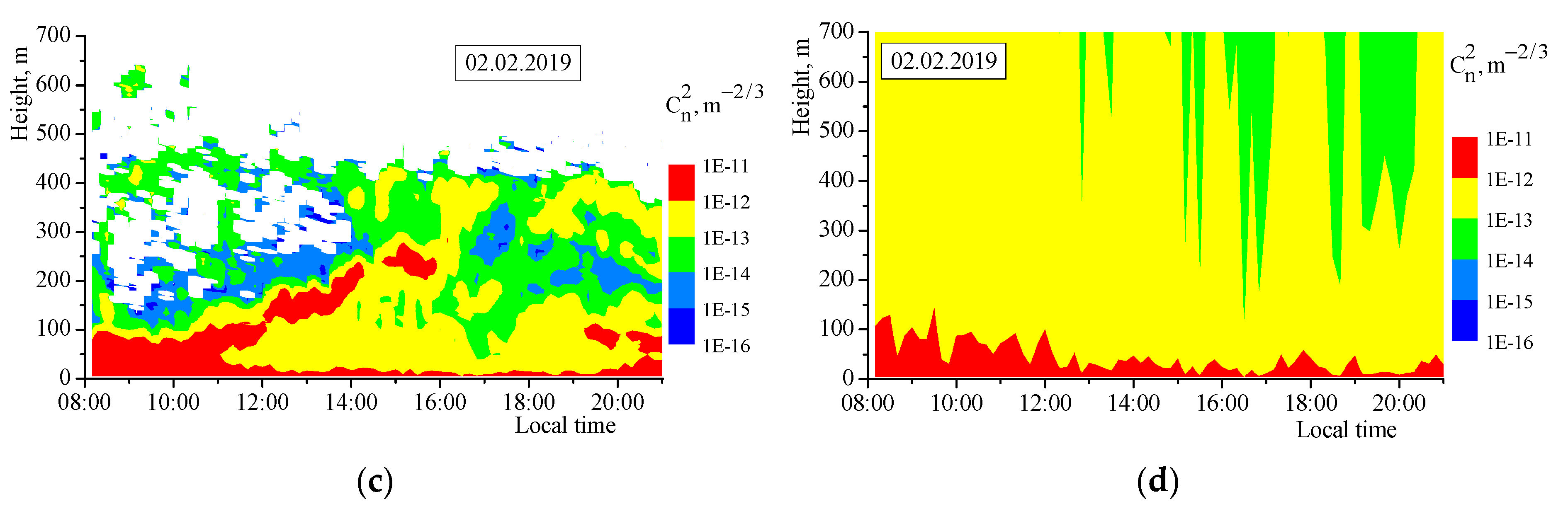
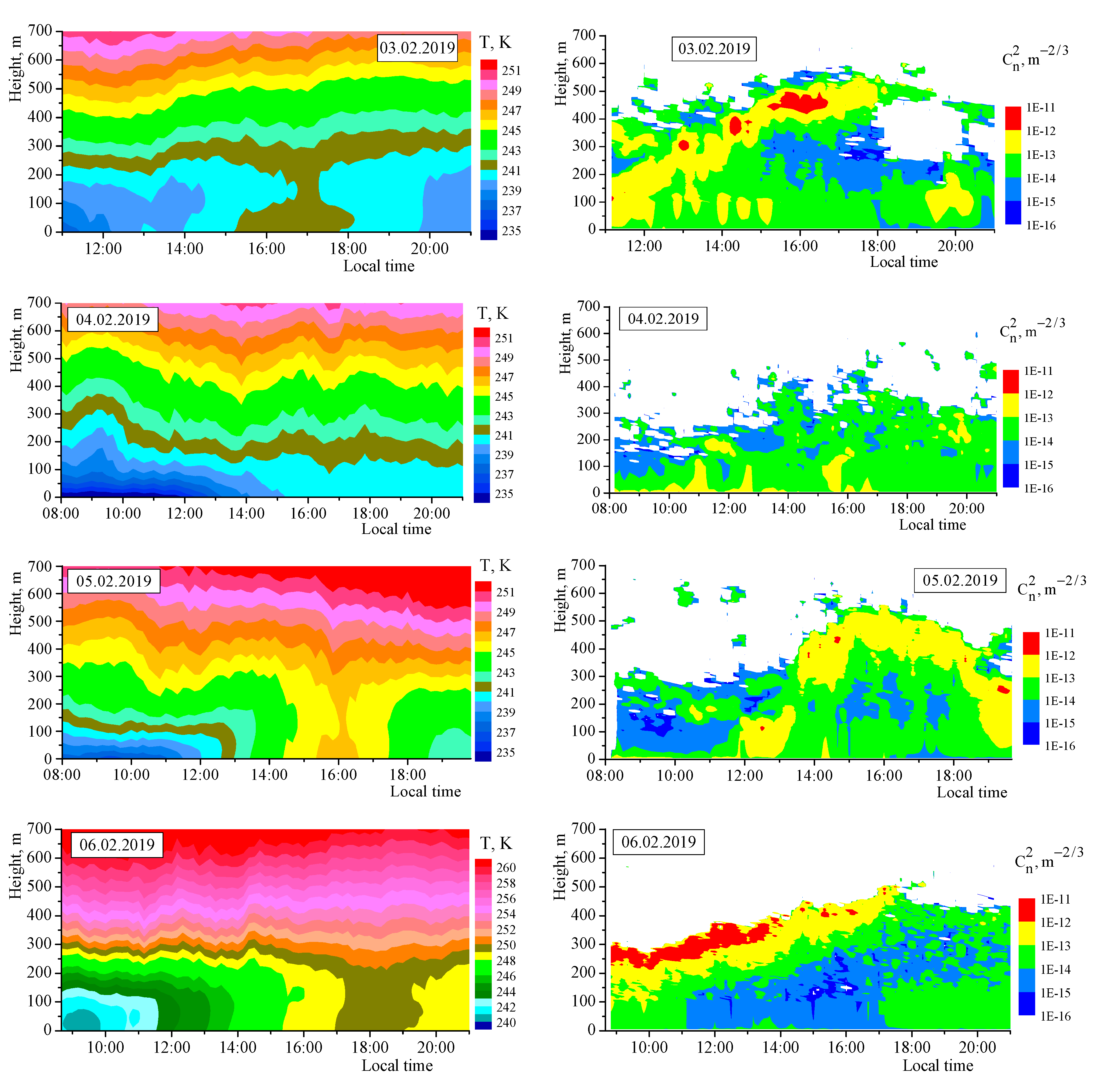

© 2019 by the authors. Licensee MDPI, Basel, Switzerland. This article is an open access article distributed under the terms and conditions of the Creative Commons Attribution (CC BY) license (http://creativecommons.org/licenses/by/4.0/).
Share and Cite
Odintsov, S.L.; Gladkikh, V.A.; Kamardin, A.P.; Nevzorova, I.V. Determination of the Structural Characteristic of the Refractive Index of Optical Waves in the Atmospheric Boundary Layer with Remote Acoustic Sounding Facilities. Atmosphere 2019, 10, 711. https://doi.org/10.3390/atmos10110711
Odintsov SL, Gladkikh VA, Kamardin AP, Nevzorova IV. Determination of the Structural Characteristic of the Refractive Index of Optical Waves in the Atmospheric Boundary Layer with Remote Acoustic Sounding Facilities. Atmosphere. 2019; 10(11):711. https://doi.org/10.3390/atmos10110711
Chicago/Turabian StyleOdintsov, Sergei L., Vladimir A. Gladkikh, Andrei P. Kamardin, and Irina V. Nevzorova. 2019. "Determination of the Structural Characteristic of the Refractive Index of Optical Waves in the Atmospheric Boundary Layer with Remote Acoustic Sounding Facilities" Atmosphere 10, no. 11: 711. https://doi.org/10.3390/atmos10110711
APA StyleOdintsov, S. L., Gladkikh, V. A., Kamardin, A. P., & Nevzorova, I. V. (2019). Determination of the Structural Characteristic of the Refractive Index of Optical Waves in the Atmospheric Boundary Layer with Remote Acoustic Sounding Facilities. Atmosphere, 10(11), 711. https://doi.org/10.3390/atmos10110711



